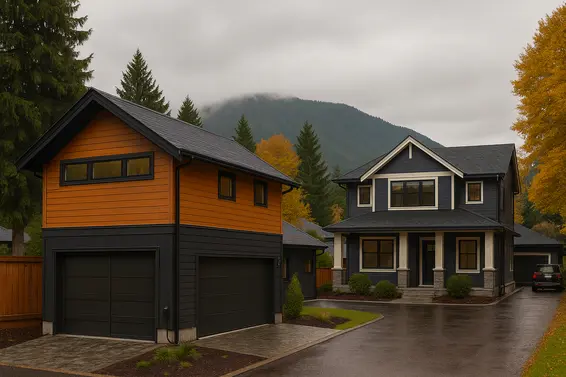Coach Houses in the District of North Vancouver
TL;DR
- What: A small detached dwelling in your rear yard, separate from the main house.
- Where: Eligible single-family lots inside DNV’s Urban Containment Boundary.
- Key rules: Up to 90 m² (≈968 sq. ft.); two storeys possible within height; 3 on-site parking spaces across the lot; typical siting is rear yard with lane access where available.
- Permits: If you meet all rules, go straight to a Building Permit. If you need relief on siting/setbacks/parking, apply for a Development Variance Permit (DVP) first, then the Building Permit.
- Timelines: DVPs commonly run 2–6 months depending on complexity and feedback.
- Costs: Possible servicing upgrades (water/sanitary/storm + meter), Hydro/Fortis hookups, construction, and District fees.
- Next step: Send me your address for a fast eligibility and density check.
What is a coach house and where are they allowed?
A coach house is a small, detached home in your rear yard. In the District of North Vancouver, coach houses are permitted on eligible single-family lots within the Urban Containment Boundary. You can have a principal dwelling, one secondary suite, and a coach house on the same lot if you meet the rules.
Key size, height, and parking rules
- Maximum floor area: up to 90 m² (about 968 sq. ft.).
- Height/form: Two storeys are possible when you meet height and roof rules.
- Parking: Plan for three on-site parking spaces across the property. One space may be within the coach house. Carports are not counted as enclosed parking.
Where it sits on your lot
Most coach houses go in the rear yard.
- Access: From the lane where one exists; on corner lots, from the lower-classification street; otherwise from the fronting street.
- Front-yard proposals: Usually require a DVP.
Two approval paths
- Building Permit only
If you meet zoning outright, apply directly for a Building Permit. If your property is also in a Development Permit Area (hazards or environment), secure that Development Permit first. - Variance path
Need a tweak to siting, setbacks, or parking? Apply for a DVP. After approval, apply for the Building Permit. Typical DVP timelines range from 2 to 6 months depending on complexity and neighbourhood input. Some minor hardship cases may go to the Board of Variance.
Cost categories to budget
- District servicing: Possible upgrades to water, sanitary, storm, plus a water meter. Off-site work may be triggered.
- Other servicing: BC Hydro and FortisBC connections are separate items.
- Build costs: Materials, labour, plans, landscaping, and professional fees vary by site conditions and market.
- Fees & charges: Building Permit, and where applicable DVP/DP fees and Amenity Cost Charges.
Smart design moves the District encourages
- Privacy-savvy windows: Clerestory, raised or corner windows; consider skylights or obscured glass on side yards.
- Good street or lane presence: Orient the front door to the lane or street; add weather protection.
- Landscaping & drainage: Retain mature trees, add screening, use permeable paving, and consider rain gardens or bioswales.
- Accessibility: Plan for level entries and lever handles if aging in place is a goal.
Practical next steps
- Eligibility check: Zoning, Urban Containment Boundary, any Development Permit Areas, and available floor space on your lot.
- Pick your path: Building Permit vs. DVP/Board of Variance.
- Build your team: Designer/architect, builder, and early conversations with DNV Planning, Building, and Engineering.
- Neighbour outreach: Helpful if you anticipate a variance.
Policy watch: OCP and Housing Needs updates
The District of North Vancouver is reviewing its Official Community Plan and continuing work on its Housing Needs analysis in 2025 to align with provincial housing targets. As these updates move forward, details on siting, size, or approval pathways for coach houses could evolve. Always confirm the latest District guidance before you apply.
FAQ
Can I have a suite and a coach house on the same lot?
Yes. On eligible lots inside the Urban Containment Boundary, DNV allows a principal home, one secondary suite, and a coach house.
How long does a DVP take?
Plan for 2–6 months depending on complexity and neighbourhood feedback.
Where should the coach house go on my lot?
Typically in the rear yard. Use the lane for access where available.
What are the biggest cost surprises?
Servicing upgrades and utility connections. Get clarity on water, sanitary, storm, and power early.
Will these rules change soon?
Possibly. DNV is updating its OCP and Housing Needs work in 2025. Check current rules before submitting.

About Matt Council, PREC
North Shore-focused Realtor with 10+ years helping homeowners in North Vancouver and West Vancouver. I specialize in detached homes, strata, and North Shore presales. If you want a quick, no-pressure read on your options, I’m here.
Call/Text: 604-317-4464 • Email: matt@rossettirealty.ca
Service areas: North Vancouver and West Vancouver - from Deep Cove to Horseshoe Bay
